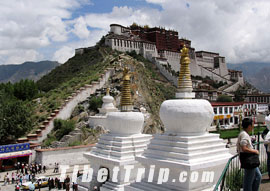 The whole construction of the stupa is very imposing and delicate. It is usually colored white and consists of three parts - a square or round base, a cylindrical body and a spire. Each of these is full of meanings related to Buddhism. The base, symbolizing the throne of Buddha, is of many layers which can be climbed. There may be a channel in the middle of the base, in which the sculptures of Buddha are enshrined. Above the base are four-tiered steps, representing the crossed legs of Buddha. The body is round, narrower towards the bottom, and resembles a monk's upside-down begging bowl. Here we will find a bronze shrine on the top usually with the Buddhist drawing of Kalacakra Seal on its obverse. Inside are deposited the mummy or Sarira of the Buddha as well as his clothing and Dharma weapons. Sutras are usually put in the middle of the bowl and medicaments along with jewels at the bottom. The top is a canopy just like the crown of Buddha which exudes our reverence to him. Seated on the canopy are 13 layered-wheels, representing the 13 stages that Buddha had experienced towards Dzogchen. The peak is designed with three symbols of star, sun and moon. The three Dharma-dhatus of Buddhism are symbolically illuminated in the stupa. According to the Tibetans, the bowl is filled with the six carnal desires, the neck above stands for the material appearance of things and the peak has reached to void of the world of senses.
The whole construction of the stupa is very imposing and delicate. It is usually colored white and consists of three parts - a square or round base, a cylindrical body and a spire. Each of these is full of meanings related to Buddhism. The base, symbolizing the throne of Buddha, is of many layers which can be climbed. There may be a channel in the middle of the base, in which the sculptures of Buddha are enshrined. Above the base are four-tiered steps, representing the crossed legs of Buddha. The body is round, narrower towards the bottom, and resembles a monk's upside-down begging bowl. Here we will find a bronze shrine on the top usually with the Buddhist drawing of Kalacakra Seal on its obverse. Inside are deposited the mummy or Sarira of the Buddha as well as his clothing and Dharma weapons. Sutras are usually put in the middle of the bowl and medicaments along with jewels at the bottom. The top is a canopy just like the crown of Buddha which exudes our reverence to him. Seated on the canopy are 13 layered-wheels, representing the 13 stages that Buddha had experienced towards Dzogchen. The peak is designed with three symbols of star, sun and moon. The three Dharma-dhatus of Buddhism are symbolically illuminated in the stupa. According to the Tibetans, the bowl is filled with the six carnal desires, the neck above stands for the material appearance of things and the peak has reached to void of the world of senses. It is believed that circumambulating clockwise round the stupa will enable the Tibetan to accumulate merit. Many stupas have been built, mostly in the temples, either for the burial of prestigious living Buddhas or worship by Tibetans. For example, almost every generation of Dalai Lama and Panchen Lama rests in the splendid stupas of Potala Palace and Tashihunpo Monastery respectively.
Perhaps the most impressive stupa in Tibet is the Ten-thousand Buddha Stupa in the Palkhor Monastery. It possesses 77 halls and shrines in the stupa, so it is also called 'the Temple in the Stupa'. There are over 10,000 images of Buddha in the paintings and statues inside, hence the name. Besides, there are also many august groups of small stupas distributed, 108 pieces generally. These can be seen in Tholing Monastery left by the ancient mysterious Guge Kingdom. The Ruins of Guge Kingdom has become a treasure to intrigue both researchers and tourists alike.








